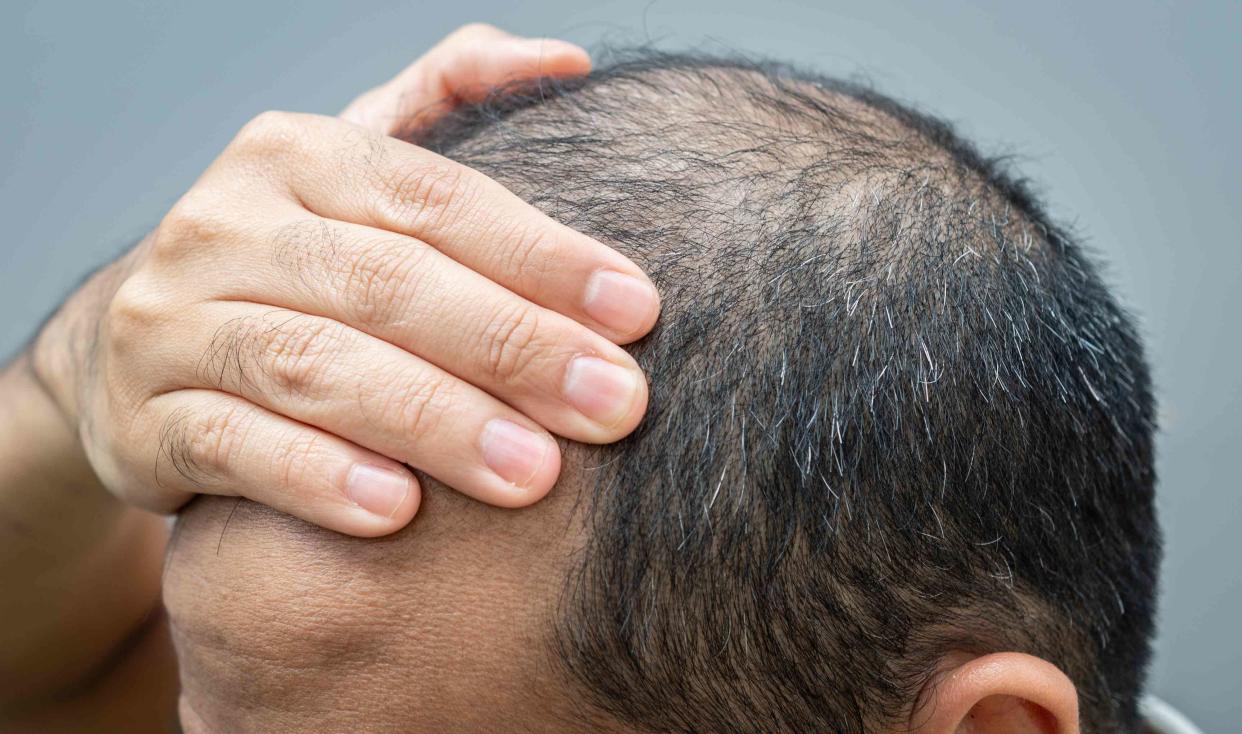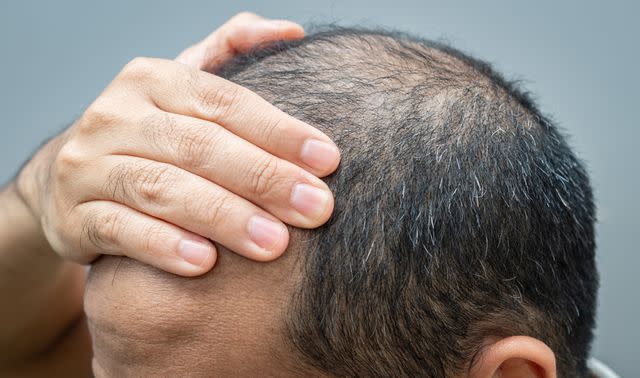Is Male- or Female-Pattern Baldness Reversible?

Boy_Anupong / Getty Images
Medically reviewed by William Truswell, MD
Androgenic alopecia, or pattern baldness, is a hair loss condition that affects both men and women. While this can be a frustrating condition, it's essential to know that there are many available treatments that can help slow down or even reverse hair loss.
This article will review male- and female-pattern baldness signs, what causes it, and potential treatment options.
It's important to note that while the terms "male-pattern baldness" and "female-pattern baldness" are commonly used, hair loss can affect individuals of any sex or gender identity. Also, when research is cited, the sex and gender terms within that reference will be used.

Boy_Anupong / Getty Images
Signs of Male- or Female-Pattern Baldness
Androgenetic alopecia is a type of hair loss commonly affecting females and males. However, it typically presents differently among the sexes. Female-pattern baldness is characterized by thinning hair on the crown (top) of the head, while male-pattern baldness typically involves a receding hairline and baldness on the crown.
Females: Hair Thinning at Crown
The pattern of hair loss in women is different from male-pattern baldness. This condition may cause hair thinning at the crown of the head, typically occurring in women in their 40s or 50s. Women may also experience hair thinning all over the scalp without their hairline receding.
This condition is caused by inheriting specific genes from one or both parents. Hormonal changes that happen during menopause may also trigger it. Androgenetic alopecia rarely results in total baldness in women.
Males: Receding Hairline and Thinning Crown
Male androgenetic alopecia (MAA) is the most common type of hair loss in men. It happens to between 30% and 50% of men by the time they're 50 years old. MAA follows a specific pattern and tends to affect the hair on the temples, the top of the head, and the middle of the front of the scalp.
In men, this condition is commonly referred to as male-pattern baldness, in which hair loss occurs in a distinct pattern that begins above the temples and causes a receding hairline to form the shape of the letter "M." Hair thinning at the crown may eventually lead to partial or complete baldness.
What Causes Pattern Baldness?
Androgenetic alopecia is a type of hair loss caused by a combination of genetic and environmental factors. Even though researchers are studying reasons for this condition, they still can't identify some causes.
However, it is known that androgenetic alopecia is linked to hormones called androgens, especially dihydrotestosterone (DHT). Androgens are important for normal male sexual development during the gestational period (in the womb) and puberty. However, they also help regulate other functions such as hair growth and sex drive. Too much DHT can cause hair loss.
DHT is widely believed to be the leading cause of male- and female-pattern baldness, as it can cause hair follicles to shrink and produce thinner, shorter hairs.
It's important to note that a combination of factors can cause hair loss, and each person's experience is unique. Other genetic and environmental factors that may also contribute to male- and female-pattern baldness include the following:
Genetics
Male- and female-pattern baldness is often inherited from one or both parents. Although researchers believe that multiple genes may contribute to androgenetic alopecia, scientific studies have confirmed that variations in a single gene, known as AR, play a role.
Hormonal Changes or Imbalances
Changes in hormone levels, such as those that occur during menopause, can contribute to hair loss. Polycystic ovary syndrome (PCOS) is a hormonal imbalance that causes cysts on the ovaries and symptoms, including hair loss.
Aging
As people age, hair follicles shrink, leading to thinner hair and eventual hair loss.
Medications
Certain medications, such as those used for cancer, arthritis, and depression, can cause hair loss. Hair loss typically reverses after discontinuing most medications.
Medical Conditions
Several medical conditions can cause hair loss, including:
Alopecia areata
Thyroid disorders
Anemia (lack of healthy red blood cells)
Syphilis (a sexually transmitted infection)
Ringworm of the scalp (a contagious fungal disease)
Bacterial infections of the scalp
High fever or severe infection
Childbirth
Major surgery, major illness, sudden blood loss
Severe emotional stress
Crash diets, especially those that do not contain enough protein
Drugs, including retinoids, birth control pills, beta-blockers, calcium channel blockers, certain antidepressants, and NSAIDs, including Advil or Motrin (ibuprofen)
Nutritional Deficiencies
Deficiencies in nutrients such as iron, vitamin D, and protein can cause hair loss.
Hairstyling Practices
Certain hairstyles, such as pulling hair tightly into braids or ponytails, can cause hair loss over time.
Stress
Extreme stress, such as that caused by illness, surgery, or trauma, can lead to hair loss.
Other Causes
Other causes of baldness may include:
Burns
Excessive shampooing and blow-drying
Nervous habits like continual hair pulling or scalp rubbing
Hairstyles that put too much tension on the hair follicles
Pattern Baldness in Women Treatment
To find the best hair loss treatment for you, you must talk to your dermatologist (medical specialist of disorders of the skin, hair, and nails) or other healthcare provider.
A dermatologist can help determine the underlying cause of hair loss, which may not be immediately apparent, and may help determine the proper course of treatment. After diagnosing the cause of hair loss, a dermatologist can create a personalized treatment plan that is effective and safe.
Hair regrowth takes time, and your dermatologist can help monitor youHere are some possible tr progress and adjust the treatment plan as needed. Treatments for female pattern baldness include the following:
Medications
Topical Rogaine (minoxidil) is an over-the-counter (OTC) solution applied to the scalp to promote hair growth and reduce the rate of balding. However, minoxidil does not affect receding hairlines and is not a cure for baldness. Also, hair regrowth stimulated by minoxidil is not permanent and may be lost within several months of discontinuing the medication.
It is advised to avoid using minoxidil if you are pregnant or breastfeeding. Minoxidil should also be used with caution in people with chronic kidney disease.
Aldactone (spironolactone) may also be used, it is an oral medication that blocks androgen hormones and can help prevent further hair loss.
Platelet-Rich Plasma Therapy
Platelet-rich plasma (PRP) for hair loss involves taking a sample of the patient's own blood, processing it to concentrate the platelets, and injecting the resulting plasma back into the scalp to promote hair growth. PRP is believed to stimulate the hair follicles and increase blood supply to the scalp, resulting in thicker and healthier hair.
At-Home Hair Regrowth Lasers
Low-level laser therapy (LLLT) for hair loss involves using a specialized device that emits low-power lasers to stimulate hair follicles and improve blood flow to the scalp. LLLT is believed to help reduce inflammation, increase cell metabolism, and ultimately lead to thicker, healthier hair.
Microneedling
Microneedling is a minimally invasive cosmetic procedure that involves puncturing the skin with small needles to promote collagen and elastin production. On the scalp, microneedling stimulates hair growth by increasing blood flow, delivering essential nutrients to hair follicles, and triggering the release of growth factors.
Pattern Baldness in Men Treatment
Many of the hair loss treatments mentioned above are also used for male-pattern baldness. However, treatment options may differ based on gender, with some medications approved exclusively for men.
Some treatments used for female-pattern baldness are not recommended for men with male-pattern baldness, and vice versa. This is because the underlying hormonal imbalances and hair loss patterns differ between men and women.
In addition to the treatment listed above, other common treatments for male-pattern baldness include:
Finasteride
Proscar or Propecia (finasteride) is an oral medication that blocks the conversion of testosterone to DHT, a hormone that can cause hair loss.
This medication has been approved by the Food and Drug Administration (FDA) for the treatment of male hair loss. Due to the risk of birth defects, it is generally not prescribed to women of reproductive age. However, postmenopausal women may receive off-label prescriptions for finasteride in certain circumstances.
Topical Minoxidil
Minoxidil is commonly used to treat both male- and female-pattern baldness. However, the recommended strengths and application methods may differ among the genders based on the severity of hair loss and other individual factors. Minoxidil solution is available in 2% and 5% solutions.
Hair Transplantation
Hair transplantation refers to a surgical procedure in which hair follicles are harvested from a donor site and then transplanted into areas on the scalp where hair is either thinning or has been lost.
Although hair transplants are successfully performed on both men and women, this procedure is significantly more common in men.
Summary
The exact causes of female- and male-pattern baldness are not yet fully understood, but genetics, hormones, and aging are thought to play a role. While there is no cure for either type of hair loss, there are several treatments available to slow down or even reverse the process, including medications, hair transplantation, and low-level laser therapy.
It's vital for individuals experiencing hair loss to consult with a primary care provider or dermatologist to determine the best course of treatment based on their individual needs and circumstances.

